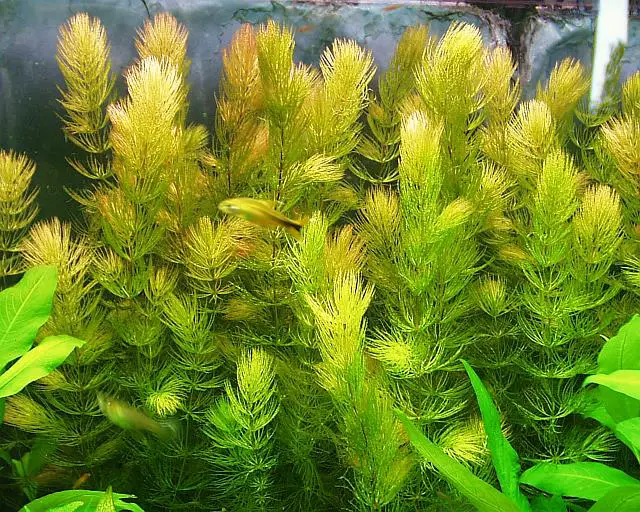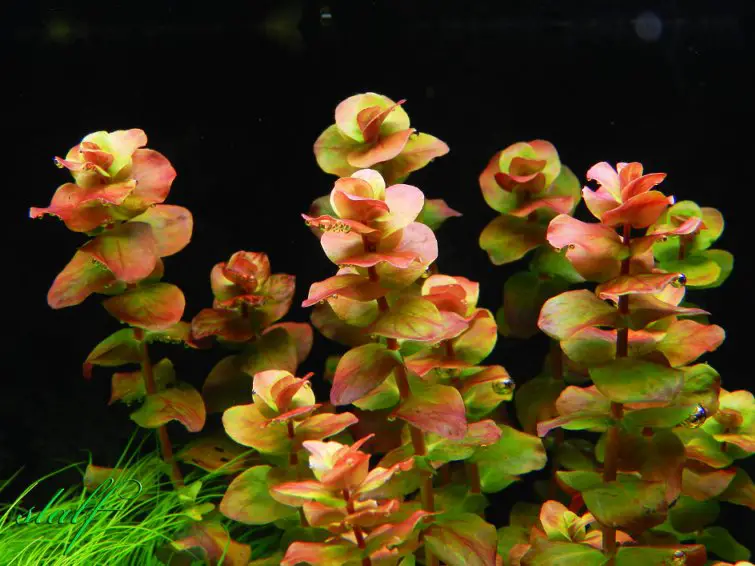To understand why Aquarium Plant Turning Yellow, you need to analyze the state of the aquatic environment and soil, illumination, and then, using the advice of experienced aquarists, correct the situation for aquarium plant care.

Table of Contents
Why do Aquarium Plant Turning Yellow?
A change in the color of the leaves indicates that the biological balance in the home reservoir is disturbed.
The causes of plant diseases can be:
- weak / intense lighting;
- unreasonably short or long daylight hours;
- inappropriate temperature regime;
- rare water change;
- insufficient filtration;
- depletion of the soil (for plants receiving nutrition from the bottom substrate) check Aquarium Substrate Guide;
- changes in the chemical composition of the aquatic environment;
- lack of carbon dioxide;
- deficiency or excess of micro- and macroelements;
- the presence of weeds or parasitic algae, herbivorous snails and fish in the aquarium.
If the reason for the appearance of yellow leaves is the depletion of the soil or a lack of light, then the problem is simple to solve: you need to increase the power of the lamps and the duration of their operation, lay a fresh layer of fertile soil on the bottom. But most often, diseases arise from an imbalance in minerals.
treatment of Aquarium Plant Turning Yellow due Macro Nutient Imbalance
It is dangerous for aquaflora to change the optimal concentration of macronutrients both up and down. The lack of mineral compounds is compensated by precisely calculated doses of the corresponding chemicals.

Novice aquarists are advised to use ready-made complex fertilizers:
- Tetra Plant Start;
- AQUAYER Udo Ermolaeva MACRO +;
- Plant Elixir, etc.
They contain minerals, growth hormones, and root stimulants to protect and strengthen plants.
An excess of mineral compounds is eliminated by a partial or complete water change, carried out in several steps in 1-2 weeks.
NITROGEN
When nitrogen starvation occurs, the edges ends, and veins of the leaf plates turn yellow, young leaves slow down growth, and old ones fall off.
There are two ways to increase the nitrogen level in water:
- Reduce the temperature of the water in the tank by a few degrees. In this case, you need to ensure that the temperature for the fish living in the aquarium remains comfortable and they do not die from hypothermia.
- Feed weekly with nitrogen-containing fertilizers or urea at the rate of 5-10 mg per 1 liter of aquarium volume.
In older aquariums, the opposite problem is more common. Excess nitrogen causes thickening of the stems, thickening of the leaves and a change in the light green color of plants to dark green.
An excess of nitrate compounds may also be evidenced by the rapid multiplication of blue-green algae (filamentous plants, flip flops, etc.). To restore the bio balance, you need to completely change the water in 4-5 steps for 15 days, rinse the soil, feed the plants with potassium and phosphorus.
PHOSPHORUS
Phosphorus deficiency is manifested by the following symptoms:
- changing the light shade of the leaves to a dark one;
- twisting of leaf plates and young shoots;
- holes, reddish or brown spots on the leaves.
To meet the needs of aqua flora in phosphorus, calcium phosphate or potassium should be added every 7-10 days at the rate of 50-500 mg per 100 liters of water.
With an excess of a chemical element, plant shoots rapidly turn yellow and shed their foliage.
SULFUR
A sign of sulfur starvation is the acquisition of a reddish or yellow tint by the leaves. The easiest way to treat in this case is to add 1-2 crystals of purified sulfur (available in the form of a yellow powder and sold in pharmacies).
The increased sulfur content accelerates the aging of plants. To restore balance, you need to temporarily abandon fertilizers containing sulfates.
CHLORINE
The increased concentration of chlorine in the water leads to the appearance of yellowness in young leaves and a reddish-brown color in old ones. To restore plants, it is useful to add 0.5 g of calcium chloride for every 100 liters of water every 7-10 days.
Excess chlorine content is indicated by:
- stop the growth of aquaflora;
- increased rigidity of green parts of plants;
- shrinking leaves.
The method of treatment is a decrease in the concentration of chlorides and a weekly water change.
CALCIUM
In regions with soft water, aqua flora may be deficient in calcium, which is manifested by the following symptoms:
- the edges of the sheet plates turn yellow;
- leaves curl;
- growth points turn black.
To restore chemical equilibrium, the landscape of the aquarium can be decorated with a large hollow shell (previously decontaminated) or decorative tuff. Feeding with universal fertilizers with calcium will not be superfluous.
If you use hard tap water to fill the aquarium, the green tissue between the leaf veins becomes covered with white circular spots.
Soft water will help restore health to plants. In addition, clamshells or pieces of limestone used to decorate the landscape should be removed from the aquarium.
POTASSIUM
The potassium source for the plants is fresh water and leftover food not eaten by the fish. With a lack of a macronutrient, the edges of the leaves wither, the surface of the leaf plates is covered with yellow spots or holes. Potassium deficiency is treated by adding 1-2 g of potassium for every 100 liters of water. As a top dressing, you can use Nitrofoska fertilizer in granules or complex formulations with a high potassium content.
When the concentration of potassium in the water exceeds the norm, the shoots of the plants are abnormally elongated and the leaves die off.
MAGNESIUM
The deficiency of alkaline earth metal leads to the appearance of white or yellow spots between the veins and the deformation of the sheet plates. Periodic (every 10-15 days) application of magnesium sulfate MgSO₄ (5-20 mg / l) helps to compensate for the lack of magnesium.
With an excess of macronutrients, young leaves bend and brighten, while old ones, on the contrary, become dark green. In such cases, it is recommended not to use fertilizers with magnesium, but to use tap water for weekly changes.
If you are in need of a solution for Aquarium Plants Melting.
Imbalancement of Essential Elements in Aquarium
Boron, iron, manganese and copper are essential for the normal development of underwater flora. Compounds of these substances are contained in complex fertilizers, which are recommended to be added to the aquarium with every water change.

IRON
Due to a lack of iron, the green parts of the aquarium plants turn yellow and glassy (become transparent). To return the rich color of stems and leaves will help weekly top dressing with iron sulfate (10-20 mg per 100 l of water).
An excess of a trace element can be easily identified by yellow leaves, on which green veins are clearly visible. You can remove an extra dose of iron by regularly changing water or feeding with manganese.
BORON
Boron deficiency provokes blackening of the apical points of growth, deformation of leaves, a change in their size downward, and in severe cases, the death of the root system.
To correct the situation, you need to add boric acid or borax every 10-15 days (10-20 mg per 100 l of water).
An excess of boron affects the state of the leaves: they turn yellow at the edges, bend dome-shaped and die off.
COPPER
With a lack of copper, the plants branch abnormally, and the leaf plates lose their rich color and turn pale. The deficiency of a chemical element is eliminated by the additional introduction of copper sulfate (1.5-2 mg / l).
Excess copper causes brown spots on the leaves, shedding of foliage and exposing stems. Such symptoms are a signal for the complete cancellation of top dressing with copper sulfate and a more frequent water change.
MANGANESE
Due to manganese starvation, plant leaves become variegated, covered with numerous light, yellow and brown spots. The deficiency condition is treated with the introduction of potassium permanganate.